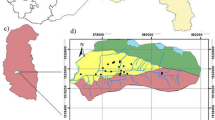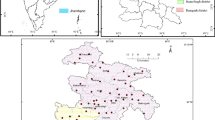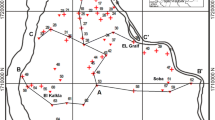Abstract
Hydrochemistry, sources of ions, identification of pollution hotspot, and potability of groundwater in shallow and deep aquifers of Palakkad and Chittur taluks (area = 1875 km2) of Bharathapuzha river basin, the largest river basin in Kerala, India, are discussed in this paper. The study area belongs to one of the rice bowls of the State. Geologically, the study area consists of Archaean crystallines, overlaid by laterite. Due to the unique geography, subhumid to semiarid climate, and intense agricultural activities, the quality of groundwater is a serious concern and warrants attention. For delineating the major ions and nutrients, water samples were analyzed for shallow (dug wells) and deep (bore wells) aquifers during monsoon (MON) and postmonsoon (POM) seasons. Physicochemical parameters showed distinct spatiotemporal variation and quality degradation, which was more prominent in deep groundwater. The relative abundance of cations and anions is in the order Na > Ca > Mg > K and HCO3 > Cl > CO3 for both the aquifers. The spatial distribution trend of parameters in deep and shallow aquifers showed a similar pattern indicating a common influence on water quality. Multivariate factor analysis (R-mode) employed in the study derived three main factors controlling the groundwater chemistry, viz. geogenic, anthropogenic, and pH. Among these, water chemistry is chiefly controlled by the geogenic factor and partly by the other two. It is also reflected well in the correlation analysis of various parameters. Since the eastern part of Chittur taluk in the study area is more impacted by anthropogenic and climatic influences, a pollution hotspot has been identified in this region through the application of Geographic Information System (GIS) overlay analysis. Thus, the study reveals agrochemical, climatic, and geologic influences on the chemistry and quality of groundwater.









Similar content being viewed by others
References
Anirudhan, S., & Thrivikramji, K. P. (1996). Sediments of the Bharathapuzha, Kerala: Implications of downstream trends of texture and grain shape. Journal of the Geological Society of India, 47, 459–465.
Anirudhan, S., Thrivikramji, K. P., & Roy Chacko, P. T. (1994). Roles of relief and climate on composition of detrital sediments of Bharathapuzha Basin Kerala. Journal of the Geological Society of India, 43, 425–433.
APHA. (1995). Standard Methods for the Examination of Water and Wastewater. (19th ed.). Washington D.C.
Appelo, C. A. J., & Postma, D. (2005). Geochemistry, groundwater and pollution. (2nd ed., p. 404p). Balkema publishers.
Aryafar, A., & Ardejani, F. D. (2013). R-mod factor analysis, a popular multivariate statistical technique to evaluate water quality in Khaf-Sangan basin, Mashhad, Northeast of Iran. Arabian Journal of Geosciences , 6, 893–900. https://doi.org/10.1007/s12517-011-0367-7.
Athira, H., & Kumar, K. N. (2016). Scenario analysis of rice cultivation in Kerala. J. Ext. Educ. https://doi.org/10.26725/JEE.2016.4.28.5760-5763.
Babu, K. N., Padmalal, D., Maya, K., Sreeja, R., & Arun, P. R. (2007). Quality of surface and groundwater around tile and brick clay mines in the Chalakudy river basin southwestern India. Jour. Geol. Soc. India, 69, 279–284.
Bagyaraj, M., Ramkumar, T., Venkatramanan, S., & Gurugnanam, B. (2012). Application of remote sensing and GIS analysis for identifying groundwater potential zone in parts of Kodaikanal Taluk. . Front. Earth Sci. https://doi.org/10.1007/s11707-012-0347-6.
Bajpayee, S. K. & Verma, A., 2001. Water quality of rivers of Kerala, South Western, India. In: V. Subramanian & A. L. Ramanathan, (Eds.), Proceedings of the International Workshop on Ecohydrology. Capital publishing company, pp. 307–308.
Bakac, M. (2000). Factor analysis applied to a geochemical study of suspended sediments from the Gediz River, western Turkey. Environmental Geochemistry and Health, 22(2), 93–111.
Berhe, B. A., Dokuz, U. E., & Celik, M. (2017). Assessment of hydrogeochemistry and environmental isotopes of surface and groundwaters in the Kutahya Plain Turkey. Journal of African Earth Sciences, 134, 230–240.
BIS. (2012). Specifications for drinking water, IS:10500:1991. . Bureau of Indian Standards.
Bohlke, J. K. (2002). Groundwater recharge and agricultural contamination. Hydrogeology Journal, 10, 153–179.
Boretti, A., & Rosa, L. (2019). Reassessing the projections of the World Water Development Report. npj Clean Water. https://doi.org/10.1038/s41545-019-0039-9.
CGWB (2013) Central Ground Water Board, Kerala region. Technical reports: Series ‘D’. Ground water information Booklet of Palakkad District.
Chattopadhyay, S., Asa Rani, L., & Sangeetha, P. V. (2005). Water quality variations as linked to landuse pattern: A case study in Chalakudy river basin Kerala. Current Science, 89(12), 2167p.
CWC (2011) Water quality hot-spots in rivers of India. Central Water Commission, India water portal, https://www.indiawaterportal.org/articles/water-quality-hot-spots-rivers-india-report-central-water-commission
Dass, S., Agarwal, M., Chaudhary, Y.S., Shrivastav, R., (2001) A study on fluoride and other water quality parameters of groundwater of district Agra (U.P.). In: V. Subramanian, A. L. Ramanathan (Eds.), Proceedings of the international workshop on ecohydrology. Capital Publishing Company, 213p.
Davis, J. C. (2002). Statistics and data analysis in geology. (pp. 526–540). Wiley.
Dubey, C. S., Pattanayak, S. K., Sharma, B. K., & Sirohi, A. (2002). Groundwater pollution in the satellite city Faridabad, India. In C. S. Dubey & P. S. Saklani (Eds.), Geoindicators and related environmental studies: focus on India. (pp. 47–56). Pilgrims Publishing.
Fasunwon, O., Olowofola, J., Akinyemi, O., Fasunwon, B. and Akintokun, O. (2008) Contaminants evaluation as water quality indicator in ago-iwoye, South-western, Nigeria, African Physical Review, 2, p. 12.
Garcia-Garizábal, I. (2012). Dynamics of an aquifer and water quality in a traditional irrigated land in the Ebro river basin. ITEA, 108, 115–130.
Garg, S. S. (2003). Water quality of well and bore well of ten selected locations of Chitrakoot region. In A. Kumar (Ed.), Aquatic environment and toxicology. (p. 114p). Daya Publishing House.
Gibbs, R. J. (1970). Mechanisms controlling world water chemistry. Science, 170, 1088–1090.
Gleick, P. H. (2000). The changing water paradigm- a look at twenty-first century water resources development. International Water Resources Association Water International, 25(1), 127–138.
Gronwall, J., & Danert, K. (2020). Regarding groundwater and drinking water access through a human rights lens: Self-supply as a norm. Water. https://doi.org/10.3390/w12020419.
Jalali, M., & Khanlari, Z. V. (2007). Major ion chemistry of groundwaters in the Damagh area, Hamadan, western Iran. Environmental Geology. https://doi.org/10.1007/s00254-007-0795-6.
Jarvie, H. P., Whitton, B. A., & Neal, C. (1998). Nitrogen and phosphorus in east coast British rivers: Speciation, sources, and biological significance. Science of the Total Environment, 210, 79–109.
Jayaprakash, M., Giridharan, L., Venugopal, T., Krishna Kumar, S. P., & Periakali, P. (2007). Characterization and evaluation of the factors affecting the geochemistry of groundwater in Neyveli, Tamil Nadu, India. Environmental Geology. https://doi.org/10.1007/s00254-007-0868-6.
Jeevanandam, M., Kannan, R., Srinivasalu, S., & Rammohan, V. (2006). Hydrogeochemistry and groundwater quality assessment of lower part of the Ponnaiyar River Basin, Cuddalore district South India. Environmental Monitoring and Assessment, 132, 263–274. https://doi.org/10.1007/s10661-006-9532-y.
Jeong, C. H. (2003). Effect of landuse and urbanization on hydrochemistry and contamination of groundwater from Taejon area, Korea. Journal of Hydrology, 235, 194–210.
Kannan, N., & Sabu, J. (2010). Quality of ground water in the shallow aquifers of a paddy dominated agricultural river basin, Kerala, India. International Journal of Environmental Science and Engineering, 2, 3.
Kannan, N., Sabu, J., & Jobin, T. (2009). Textural characteristics, organic carbon, and nitrogen content in the paddy soils of Palakkad district, Kerala India. Pollution Research, 28(2), 161–163.
Komor, S. C., & Anderson, H. W. (1993). Nitrogen isotopes as indicators of nitrate sources in Minnesota sand-plain aquifers. Ground Water, 31, 260–270.
Kumar, V. S., Amarender, B., Dhakate, R., Sankaran, S., & Kumar, K. R. (2016). Assessment of groundwater quality for drinking and irrigation use in shallow hard rock aquifer of Pudunagaram, Palakkad District Kerala. Applied Water Science, 6, 149–167. https://doi.org/10.1007/s13201-014-0214-6.
Ledoux, E., Gomez, E., Monget, J. M., Viavattene, C., Viennot, P., Ducharne, A., & Mary, B. (2007). Agriculture and groundwater nitrate contamination in the Seine basin. The STICS–MODCOU modelling chain. Science of the Total Environment, 375(1), 33–47.
Lloyd, J. W., & Heathcote, J. A. (1985). Natural inorganic hydrochemistry in relation to groundwater. (p. 294p). Claredon Press.
Manjula, C., & Warrier, U. (2019). Evaluation of water quality of Thuthapuzha Sub-basin of Bharathapuzha, Kerala India. Applied Water Science, 9, 70. https://doi.org/10.1007/s13201-019-0937-5.
Meyback, M. (1987). Global chemical weathering of surficial rocks estimated from river dissolved loads. American Journal of Science, 287, 401–428.
Olmez, L., Jack, W. B., & Villaume, J. F. (1994). A new approach to understanding multiple-source groundwater contamination: Factor analysis and chemical mass balance. Water Research, 28, 1095–1101.
Parimala Gandhi, K. (2008). Analysis of water quality parameters in selected areas of Palakkad district. Current World Environment, 3(2), 283–287.
Pawar, N. J., Pondhe, G. M., & Patil, S. F. (1998). Groundwater pollution due to sugar mill effluent at Sonai, Maharashtra, India. Environmental Geology, 34(2–3), 151–158.
Purushotham, D., Prakash, M. R., & Rao, A. N. (2011). Groundwater depletion and quality deterioration due to environmental impacts in Maheshwaram watershed of R.R. District, AP (India). Environmental Earth Science, 62(8), 1707–1721.
Raghunath, R., Sreedhara Murthy, T. R., & Raghavan, B. R. (2001). Spatial distribution of pH, EC and total dissolved solids of Nethravathi river basin, Karnataka state, India. Poll. Res., 20(3), 413–418.
Raj, N. and Azeez, P.A., (2009) Spatial and temporal variation in surface water chemistry of a tropical river, the river Bharathapuzha, India. Current Science, 96(2).
Ramesh, R., (2001) Point and non-point sources of groundwater pollution: case studies along the East Coast of India. In: V Subramanian and A. L. Ramanathan (Eds), Proceedings of the international workshop on ecohydrology. Capital Publishing Company, 107p.
Rao, P. M., Sekhar, P., & Yadav, Y. S. (2004). Water quality studies on Kolleru lake and its infalling drains of A.P., India. In A. Kumar (Ed.), Water pollution. (p. 171p). APH publishing corporation.
Ravindrakumar, G. R., & Chacko, T. (1994). Geothermobarometry of mafic granulites and metapelite from the Palghat Gap, South India: petrological evidence for isothermal uplift and rapid cooling. Journal of Metamorphic Geology, 1, 479–492.
Saha, D., Dhar, Y. R., & Sikdar, P. K. (2008). Geochemical Evolution of Groundwater in the Pleistocene Aquifers of South Ganga Plain Bihar. Journal of the Geological Society India, 71, 473–482.
Sami, K. (1992). Recharge mechanisms and geochemical processes in a semi-arid sedimentary basin, Eastern cape South Africa. Journal of Hydrology, 139, 27–48.
Satheesh Kumar, R., (2001) Geology and Structure of a part of Achankovil Shear Zone (Unpublished doctoral thesis, University of Kerala)
Sawyer, C. N., & McCarty, P. L. (1967). Chemistry for sanitary engineers. (2nd ed., p. 518p). McGraw-hill.
Shaji, E., Bindu, J. V., & Thambi, D. S. (2007). High fluoride in groundwater of Palghat district, Kerala. Current Science, 240(92), 2–25.
Shaji, E., Gomez-Alday, J. J., Hussein, S., Deepu, T. R., & Anilkumar, Y. (2018). Salinization and deterioration of groundwater quality by Nitrate and Fluoride in the Chittur Block, Palakkad Kerala. Journal of the Geological Society of India, 92, 337–345.
Shivran, H. S., Dinesh Kumar, D., & Singh, R. V. (2006). Improvement of water quality though biological denitrification. Journal of Environmental Science & Engineering, 48(1), 57–60.
Soman, K. (1997). Geology of Kerala, published by Geological Society of India, Bangalore, India-560019, 280p.
SPSS, (1997) SPSS base statistics, version 13.0. Chicago, USA: SPSS Inc.
Stimson, J., Frape, S., Drimmie, R., & Rudolph, D. (2001). Isotopic and geochemical evidence of regional-scale anisotropy and interconnetivity of an alluvial fan system, Cochabamba Valey, Bolivia. Applied Geochemistry, 16, 1097–1114.
Stites, W., & Kraft, G. J. (2001). Nitrate and chloride loading to groundwater from an irrigated North-Central U. S. Sand- Plain vegetable field. Journal of Environmental Quality, 30, 1176–1184.
Subbarao, C., Subbarao, N. V., & Chandu, S. N. (1996). Characterisation of ground water contamination using factor analysis. Environmental Geology, 28, 175–180.
Subramani, T., Elango, L., & Damodaraswamy, S. R. (2005). Groundwater quality and its suitability for drinking and agricultural use in Chithar River basin, Tamilnadu, India. Journal of Environmental Geology, 47, 1099–1110.
Takem, G. E., Chandrasekharam, D., Ayonghe, S. N., & Thambidurai, P. (2010). Pollution character-ristics of alluvial groundwater from springs and bore wells in semi-urban informal settlements of Douala, Cameroon Western Africa. Environment Earth Science, 61(2), 287–298.
Todd, D. K. (2001) Groundwater hydrology, 2nd edition, Wiley, p. 334.
Tyagi, P. D., Buddhi, R., Chaudhary, K. C., & Sawhney, R. L. (2002). Degradation of ground water quality in industrial area in India. India Journal Environment Protect, 20, 174–181.
Wassenaar, L. (1995). Evaluation of the origin and fate of nitrate in the Abbotsford Aquifer using the isotopes of 15N and 18O in NO3 _. Applied Geochemistry, 10, 391–405.
WHO, (1996) Guidelines for drinking water, Vol. 2, Recommendations, World Health Organization.
Acknowledgements
The authors thank University Grants Commission, New Delhi, India, for funding in the form of a major research project (No:- F.30-101/2004 (SR)).
Author information
Authors and Affiliations
Corresponding author
Additional information
Publisher's Note
Springer Nature remains neutral with regard to jurisdictional claims in published maps and institutional affiliations.
About this article
Cite this article
Kannan, N., Joseph, S. & Sheela, A.M. Characterization of Groundwater in the Shallow and Deep Aquifers of an Agriculture-Dominated Tropical Subhumid to Semiarid Region, India: a Multivariate and GIS Approach. J Indian Soc Remote Sens 49, 1853–1868 (2021). https://doi.org/10.1007/s12524-021-01356-z
Received:
Accepted:
Published:
Issue Date:
DOI: https://doi.org/10.1007/s12524-021-01356-z




